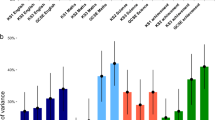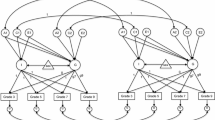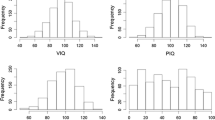Abstract
The primary objectives of the present study are to introduce the Colorado Longitudinal Twin Study of Reading Disability, the first longitudinal twin study in which subjects have been specifically selected for having a history of reading difficulties, and to present some initial assessments of the stability of reading performance and cognitive abilities in this sample. Preliminary examination of the test scores of 124 twins with a history of reading difficulties and 154 twins with no history of reading difficulties indicates that over the 5- to 6-year interval between assessments, cognitive and reading performance are highly stable. As a group, those subjects with a history of reading difficulties had substantial deficits relative to control subjects on all measures at initial assessment, and significant deficits remained at follow-up. The stability noted for all cognitive and achievement measures was highest for a composite measure of reading, whose average stability correlation across groups was 0.80. Results of preliminary behavior genetic analyses for this measure indicated that shared genetic influences accounted for 86% and 49% of the phenotypic correlations between the two assessments for twin pairs with and without reading difficulties, respectively. In addition, genetic correlations reached unity for both groups, suggesting that the same genetic influences are manifested at both time points.

Similar content being viewed by others

References
Achenbach, T. A., & Rescorla, L. A. (2001). Manual for the ASEBA School-age Forms and Profiles. Burlington, VT: University of Vermont, Research Center for Children, Youth, and Families.
American Psychiatric Association (1994). Diagnostic and statistical manual of mental disorders: DSM-IV. Washington, DC: American Psychiatric Association.
Astrom, R. L., Wadsworth, S. J., & DeFries, J. C. (2007). Etiology of the stability of reading difficulties: The longitudinal Twin Study of Reading Disabilities. Twin Research and Human Genetics, 10, 434.
Badian, N. A. (1999). Reading disability defined as a discrepancy between listening and reading comprehension: A longitudinal study of stability, gender differences, and prevalence. Journal of Learning Disabilities, 32, 138–148.
Bailey, C. E., Manis, F. R., Pedersen, W. C., & Seidenberg, M. S. (2004). Variation among developmental dyslexics: Evidence from a printed-word-learning task. Journal of Experimental Child Psychology, 87, 125–154.
Barkley, R. A., & Murphy, K. (1998). Attention-deficit hyperactivity disorder: A clinical workbook (2nd ed.). New York: Guilford Press.
Bast, J., & Reitsma, P. (1998). Analyzing the development of individual differences in terms of Matthew effects in reading: Results from a Dutch longitudinal study. Developmental Psychology, 34, 1373–1399.
Betjemann, R. S., Willcutt, E. G., Olson, R. K., Keenan, J. M., DeFries, J. C., & Wadsworth, S. J. (2007). Etiology of the stability of reading comprehension and its relation with word reading. Reading and Writing: An International Journal (in press).
Byrne, B., Samuelsson, S., Wadsworth, S., Hulslander, J., Corley, R., DeFries, J. C., et al. (2007). Longitudinal twin study of early literacy development: Preschool through Grade 1. Reading and Writing: An Interdisciplinary Journal, 20, 77–102.
Carey, G. (2005). Cholesky problems. Behavior Genetics, 35, 653–65.
DeFries, J. C. (1985). Colorado reading project. In D. B. Gray, & J. F. Kavanagh (Eds.) Biobehavioral measures of dyslexia (pp. 107–122). Parkton, MD: York Press.
DeFries, J. C., Filipek, P. A., Fulker, D. W., Olson, R. K., Pennington, B. F., Smith, S. D., et al. (1997). Colorado learning disabilities research center. Learning Disabilities: A Multidisciplinary Journal, 8, 7–19.
DeFries, J. C., & Fulker, D. W. (1985). Multiple regression analysis of twin data. Behavior Genetics, 15, 467–473.
DeFries, J. C., & Fulker, D. W. (1988). Multiple regression analysis of twin data: Etiology of deviant scores versus individual differences. Acta Geneticae Medicae et Gemellologiae, 37, 205–216.
DeFries, J. C., Plomin, R., Vandenberg, S. G., & Kuse, A. R. (1981). Parent-offspring resemblance for cognitive abilities in the Colorado Adoption Project: Biological adoptive, and control parents and one-year-old children. Intelligence, 5, 245–277.
DeFries, J. C., Singer, S. M., Foch, T. T., & Lewitter, F. I. (1978). Familial nature of reading disability. British Journal of Psychiatry, 132, 361–367.
Denckla, M. B., & Rudel, R. G. (1976). Rapid “automatized” naming (R.A.N): Dyslexia differentiated from other learning disabilities. Neuropsychologia, 14, 471–479.
Dunn, L. M., & Markwardt, F. C. (1970). Examiner’s manual: Peabody individual achievement test. Circle Pines, MN: American Guidance Service.
Fisher, S. E., & DeFries, J. C. (2002). Developmental dyslexia: Genetic dissection of a complex cognitive trait. Nature Reviews Neuroscience, 3, 767–780.
French, J. W., Ekstrom, R. G., & Price, L. A. (1963). Manual for a kit of reference tests for cognitive factors. Princeton, NJ: Educational Testing Service.
Gayán, J., Willcutt, E. G., Fisher, S. E., Francks, C., Cardon, L. R., Olson, R. K., et al. (2005). Bivariate linkage scan for reading disability and attention-deficit/hyperactivity disorder localizes pleiotropic loci. Journal of Child Psychology and Psychiatry, 46, 1045–1056.
Griffiths, Y. M., & Snowling, M. J. (2002). Predictors of exception word and nonword reading in dyslexic children: The severity hypothesis. Journal of Educational Psychology, 94, 34–43.
Harlaar, N., Dale, P. S., & Plomin, R. (2007). From learning to read to reading to learn: Substantial and stable genetic influence. Child Development, 78, 116–131.
Harlaar, N., Spinath, F. M., Dale, P. S., & Plomin, R. (2005). Genetic influences on early word recognition abilities and disabilities: a study of 7-year-old twins. Journal of Child Psychology and Psychiatry, 46, 373–384.
Hulslander, J., Olson, R., & Wadsworth, S. (submitted for review). Longitudinal stability of reading skill profiles.
Kovacs, M. (1988). The children’s depression inventory manual. New York: Multi-Health Systems, Inc.
Lyytinen, H., Ahonen, T., Eklund, K., Guttorm, T. K., Laakso, M.-L., Leinonen, S., et al. (2001). Developmental pathways of children with and without familial risk for dyslexia during the first years of life. Developmental Neuropsychology, 20(2), 539–558.
Markwardt Jr., F. C. (1989). Peabody individual achievement test–revised. Circle Pines, MN: American Guidance Service.
Maughan, B., Hagell, A., Rutter, M., & Yule, W. (1994). Poor readers in secondary school. Reading and Writing: An Interdisciplinary Journal, 6, 125–150.
McGee, R., Prior, M., Williams, S., Smart, D., & Sanson, A. (2002). The long-term significance of teacher-rated hyperactivity and reading ability in childhood: Findings from two longitudinal studies. Journal of Child Psychology and Psychiatry, 43, 1004–1017.
McKinney, J. D. (1994). Methodological issues in longitudinal research in learning disabilities. In S. Vaugh, & C. Bos (Eds.) Research issues in learning disabilities: Theory, methodology, assessment, and ethics (pp. 202–230). New York: Springer-Verlag.
Meng, H., Smith, S. D., Hager, K., Held, M., Liu, J., Olson, R. K., et al. (2005). DCDC2 is associated with reading disability and modulates neuronal development in the brain. Proceedings of the National Academy of Sciences, 102, 17053–17058.
Moffitt, T. E. (2002). Teen-aged mothers in contemporary Britain. Journal of Child Psychology and Psychiatry, 43, 727–742.
Muthén, L. K., & Muthén, B. O. (1998–2007). M-plus user’s guide (4th ed.). Los Angeles, CA: Muthén & Muthén.
Neale, M. C., Boker, S. M., Xie, G., & Maes, H. H. (2003). Mx: Statistical modeling. VCU Box 900126, Richmond, VA 23298: Department of Psychiatry. 6th ed.
Nichols, R. C., & Bilbro, W. C. (1966). The diagnosis of twin zygosity. Acta Genetica, 16, 265–275.
Olson, R. K., Datta, H., Gayán, J., & DeFries, J. C. (1999). A behavioral-genetic analysis of reading disabilities and component processes. In R. Klein, & P. McMullen (Eds.) Converging methods for understanding reading and dyslexia (pp. 133–151). Cambridge, MA: MIT Press.
Olson, R. K., Forsberg, H., & Wise, B. (1994). Genes, environment, and the development of orthographic skills. In V. W. Berninger (Ed.) The varieties of orthographic knowledge I: Theoretical and developmental issues (pp. 27–72). Dordrecht, The Netherlands: Kluwer Academic Publishers.
Olson, R., Forsberg, H., Wise, B., & Rack, J. (1994). Measurement of word recognition, orthographic, and phonological skills. In G. R. Lyon (Ed.) Frames of reference for the assessment of learning disabilities: New views on measurement issues (pp. 243–277). Baltimore: Paul H. Brookes Publishing Co.
Petrill, S. A., Deater-Deckard, K., Thompson, L. A., Schatschneider, C., Dethorne, L. S., & Vandenbergh, D. J. (2007). Longitudinal genetic analysis of early reading: The Western Reserve Reading Project. Reading and Writing, 20, 127–146.
Plomin, R., & Kovas, Y. (2005). Generalist genes and learning disabilities. Psychological Bulletin, 131, 592–617.
Raskind, M. H., Gerber, P. J., Goldberg, R. J., Higgins, E. L., & Herman, K. L. (1998). Longitudinal research in learning disabilities: Report on an international symposium. Journal of Learning Disabilities, 31, 266–277.
Raskind, M. H., Higgins, E. L., Goldberg, R. J., & Herman, K. L. (1999). Patterns of change and predictors of success in individuals with learning disabilities: Results from a twenty-year longitudinal study. Thalamus, 16, 40–64.
Reich, W., Welner, Z., & Herjanic, B. (1997). Diagnostic Interview for Children and Adolescents—IV. North Towanda Falls, NY: Multi-Health System, Inc.
Reynolds, C. R., & Richmond, B. O. (1985). Revised children’s manifest anxiety scale manual. Los Angeles: Western Psychological Services.
Rutter, M., Caspi, A., Fergusson, D., Horwood, L. J., Goodman, R., Maughan, B., et al. (2004). Sex differences in developmental reading disability: New findings from 4 epidemiological studies. Journal of the American Medical Association, 291, 2007–2012.
Satz, P., Buka, S. L., Lipsitt, L. P., & Seidman, L. (1998). The long-term prognosis of learning disabled children: A review of studies (1954–1993). In B. K. Shapiro, P. J. Accardo, & A. J. Capute (Eds.) Reading disability: A view of the spectrum (pp. 223–250). Timonium, MD: York Press.
Scarborough, H. S., & Parker, J. D. (2003). Children's learning and teachers’ expectations: Matthew effects in children with learning disabilities: Development of reading, IQ, and psychosocial problems from grade 2 to grade 8. Annals of Dyslexia, 53, 47–71.
Schmitz, S., Cherny, S. S., & Fulker, D. W. (1998). Increase in power through multivariate analyses. Behavior Genetics, 28, 357–364.
Schumacher, J., Hoffmann, P., Schmael, C., Schulte-Körne, G., & Nöthen, M. M. (2007). Genetics of dyslexia: The evolving landscape. Journal of Medical Genetics, 44, 289–297.
Shaywitz, B. A., Fletcher, J. M., & Shaywitz, S. E. (1995). Defining and classifying learning disabilities and attention-deficit/hyperactivity disorder. Journal of Child Neurology, 10, S50–57.
Shaywitz, S. E., Escobar, M. D., Shaywitz, B. A., Fletcher, J. M., & Makuch, R. (1992). Evidence that dyslexia may represent the lower tail of a normal distribution of reading disability. New England Journal of Medicine, 326, 144–150.
Shaywitz, S. E., Fletcher, J. M., Holahan, J. M., Shneider, A. E., Marchione, K. E., Stuebing, K. K., et al. (1999). Persistence of dyslexia: The Connecticut Longitudinal Study at adolescence. Pediatrics, 104, 1351–1359.
Shaywitz, S. E., Shaywitz, B. A., Fulbright, R. K., Skudlarski, P., Mencl, W. E., Constable, T., et al. (2003). Neural systems for compensation and persistence: Young adult outcome of childhood reading disability. Biological Psychiatry, 54, 25–33.
Speece, D. L., & Ritchey, K. D. (2005). A longitudinal study of the development of oral reading fluency in young children at risk for reading failure. Journal of Learning Disabilities, 38, 387–399.
Spira, E. G., Bracken, S. S., & Fischel, J. E. (2005). Predicting improvement after first-grade reading difficulties: The effects of oral language, emergent literacy, and behavior skills. Developmental Psychology, 41, 225–234.
Stanovich, K. E. (1986). Matthew effects in reading: Some consequences of individual differences in the acquisition of literacy. Reading Research Quarterly, 21, 360–407.
Stevenson, J., Langley, K., Pay, H., Payton, A., Worthington, J., Ollier, W., et al. (2005). Attention deficit hyperactivity disorder with reading disabilities: Preliminary genetic findings on the involvement of the ADRA2A gene. Journal of Child Psychology and Psychiatry, 46, 1081–1088.
Torgesen, J., Wagner, R., & Rashotte, C. A. (1999). A Test of Word Reading Efficiency (TOWRE). Austin, TX: PRO-ED.
Trzesniewski, K. H., Moffitt, T. E., Caspi, A., Taylor, A., & Maughan, B. (2006). Revisiting the association between reading achievement and antisocial behavior: New evidence of an environmental explanation from a twin study. Child Development, 77, 72–88.
Vogel, S. A. (1990). Gender differences in intelligence, language, visual-motor abilities, and academic achievement in students with learning disabilities: A review of the literature. Journal of Learning Disabilities, 23, 44–52.
Vukovic, R. K., & Siegel, L. S. (2006). The double-deficit hypothesis: A comprehensive analysis of the evidence. Journal of Learning Disabilities, 39, 25–47.
Wadsworth, S. J., Corley, R. P., Plomin, R., Hewitt, J. K., & DeFries, J. C. (2006). Genetic and environmental influences on continuity and change in reading achievement in the Colorado Adoption Project. In A. Huston, & M. Ripke (Eds.) Developmental contexts of middle childhood: Bridges to adolescence and adulthood (pp. 87–106). New York: Cambridge University Press.
Wadsworth, S. J., & DeFries, J. C. (2005). Genetic etiology of reading difficulties in boys and girls. Twin Research and Human Genetics, 8, 594–601.
Wechsler, D. (1974). Examiners’ manual: Wechsler intelligence scale for children-revised. New York: The Psychological Corporation.
Wechsler, D. (1981). Examiners’ manual: Wechsler adult intelligence scale-revised. New York: The Psychological Corporation.
Wechsler, D. (1991). Examiners’ manual: The Wechsler intelligence scale for children (3rd ed.). San Antonio, TX: The Psychological Corporation.
Wechsler, D. (1997). Examiners’ manual: The Wechsler adult intelligence scale (3rd ed.). San Antonio, TX: The Psychological Corporation.
Wechsler, D. (2002). Examiners’ manual: The Wechsler individual achievement test (2nd ed.). San Antonio, TX: The Psychological Corporation.
Wilkinson, G. S. (1993). Examiner’s manual: Wide range achievement test–3. Wilmington, DE: Jastak Associates-Wide Range Inc.
Willcutt, E. G., DeFries, J. C., Pennington, B. F., Smith, S. D., Cardon, L. R., & Olson, R. K. (2003). Genetic etiology of comorbid reading difficulties. In R. Plomin, J. C. DeFries, I. W. Craig, & P. McGuffin (Eds.) Behavioral genetics in the postgenomic era (pp. 227–246). Washington, D.C.: American Psychological Association.
Willcutt, E. G., & Pennington, B. F. (2000). Psychiatric comorbidity in children and adolescents with reading disability. Journal of Child Psychology and Psychiatry, 41, 1039–1048.
Willcutt, E. G., Pennington, B. F., Smith, S. D., Cardon, L. R., Gayán, J., Knopik, V. S., et al. (2002). Quantitative trait locus for reading disability on chromosome 6p is pleiotropic for ADHD. American Journal of Medical Genetics (Neuropsychiatric Genetics), 114, 260–268.
Williams, J., & O’Donovan, M. C. (2006). The genetics of developmental dyslexia. European Journal of Human Genetics, 14, 681–689.
Acknowledgments
The Colorado Learning Disabilities Research Center is supported by grant HD-27802 from the National Institute of Child Health and Human Development (NICHD). The Longitudinal Twin Study of Reading Disability is supported by grant DC-05190 from the National Institute on Deafness and other Communication Disorders (NIDCD). The continued cooperation of the many families participating in the CLCRC and LTSRD and the work of the staff members of these projects is gratefully acknowledged.
Author information
Authors and Affiliations
Corresponding author
Rights and permissions
About this article
Cite this article
Wadsworth, S.J., DeFries, J.C., Olson, R.K. et al. Colorado longitudinal twin study of reading disability. Ann. of Dyslexia 57, 139–160 (2007). https://doi.org/10.1007/s11881-007-0009-7
Received:
Accepted:
Published:
Issue Date:
DOI: https://doi.org/10.1007/s11881-007-0009-7



